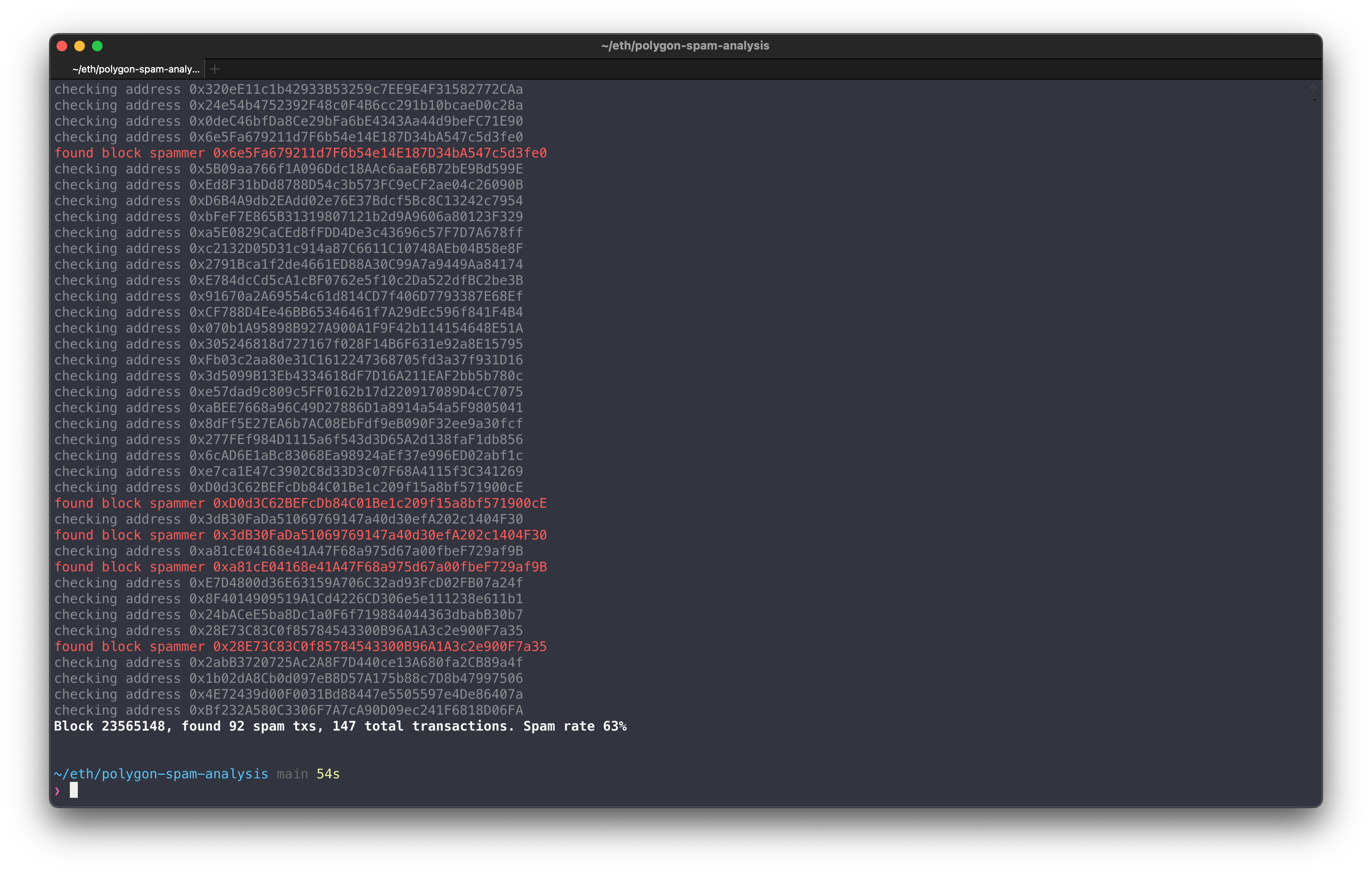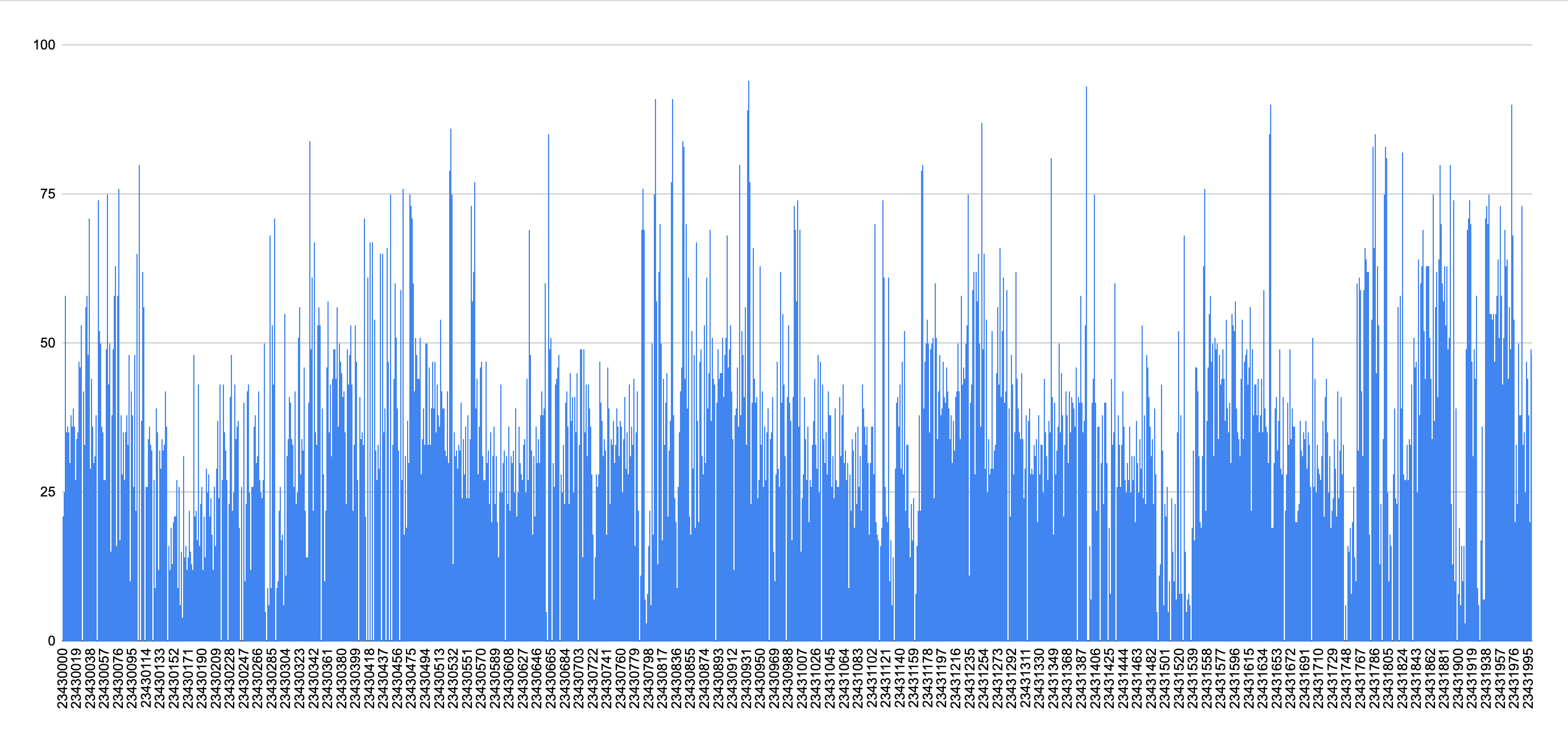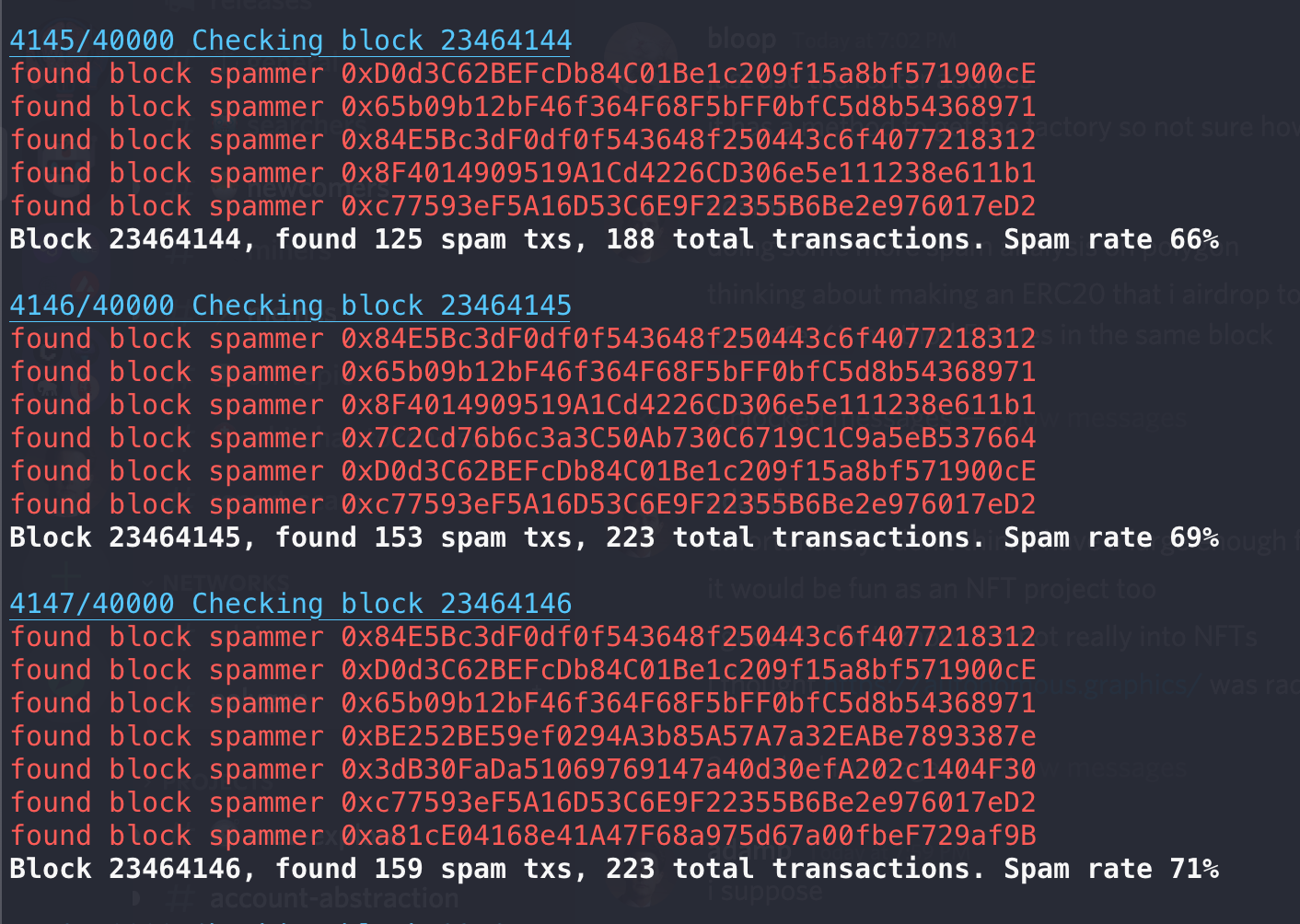-
Notifications
You must be signed in to change notification settings - Fork 553
Reduce competitive spam by having sentries always send full transactions to validators #292
New issue
Have a question about this project? Sign up for a free GitHub account to open an issue and contact its maintainers and the community.
By clicking “Sign up for GitHub”, you agree to our terms of service and privacy statement. We’ll occasionally send you account related emails.
Already on GitHub? Sign in to your account
Conversation
|
Here is a tool for analyzing the spam % in a given block: https://github.com/ajb/polygon-spam-analysis. (It uses the Polygonscan API to find the transaction counts of any smart contracts that are being called.) One example: |
|
@ajb would be really interesting to see a historical analysis of this (maybe over a week worth of blocks) and what % of the network activity is bot spam. This is worth reporting publicly as spam is a corrupting influence on chain usage metrics |
Thanks, I agree. I have updated the analysis script to use these rules to mark spam:
I'm not prepared to run it on a week's data quite yet, and would probably need some pointers on how to best analyze that amount of data. (i think this would be around ~250k blocks or so.) I did just run it for 2,000 blocks (> 1 hour) and here are some of the results:
|
|
Hello, First of all thank for the work you have put both on the spam analysis tool and the PR. Unfortunately, as of now I cannot merge this PR. These are the core points of my thinking:
Besides, we are working on in-house observability tools like this that will help us to be more proactive with this kind of situations. |
|
Hi @ferranbt, thanks for the detailed response.
This is definitely understandable. But if we agree on the core points, then what about a PR that adds a config option for sentries to specify exactly who the validators are?
Do you have different parameters that you'd recommend using in order to identify spam? I am happy to adjust the heuristic that I am using in that repository. In my opinion, the overall spam problem is pretty low, i.e. during "normal" periods, it is around 10-20%. But during "high traffic" periods, such as market downturns, the spam rate is way higher, sometimes above 50% for long ranges.
Can you share details of these plans? |
Just this week I did a full refactor of the Bor network stack here. Once we have control of the network stack and we are free to make changes (this is, we do not have to worry about upstream Go-ethereum changes) we are open for several options:
Besides, as you also mentioned, I want to make sentry nodes a native entity of the Bor client and make it configurable from config file or CLI.
I am still a bit new on MEV so I cannot give you specific parameters to test. This is the reason why we want to invest in observability, to be more proactive instead of reactive to the problem. |
|
Cool, sounds like an awesome update you are working on. I understand and agree that waiting for those changes might make the most sense. When I get some time, I will work on making the spam analysis more solid and verifying that it is producing the correct output, i.e. not marking any legitimate contract usage as spam. I can also share my definition of "spam" so that it is clearer. p.s. feel free close this PR if you'd like |
That sounds perfect to me. The more understanding we have of the problem the better we can target the solution.
Yes, I will be closing the PR for now. We already keep track of this internally. |
|
Thanks Ferran! Btw, I'm not affiliated, but this event tomorrow looks like it will discuss this problem if you have the time to tune in: flashbots/mev-research#68 (see "MEV on Polygon in 2021: A Case-Study of MEV on Low-Fee Chains by Supragya Raj") |
|
Just published a bunch more data to https://github.com/ajb/polygon-spam-analysis. I can verify that I've manually confirmed that the labeling of spam vs. not spam is working, at least in terms of my personal definition of spam. I might be missing some bots, too, as I only included contracts that were called at least 5 times in a block. The high level summary is that when you zoom out to a large time period, the level of spam is not that high, maybe like 5-10% of all transactions and a similar percentage of unique EOAs. However, whenever there is an arbitrage opportunity (for example), you will get a few blocks in a row that look like this: Whether or not it's a "problem" I guess just depends on who you are. If you are a user who is trying to get a transaction confirmed during one of these periods, it might be frustrating and definitely leads to a degraded UX. |
|
What I conclude from this is that MEV on polygon is exclusive to the validators. These are the fights between 100% validators seeking the same opportunity. They don't need this PR because they surely are already running their tweaked BORS Best solution I think would be just open the validator pool to everyone, like all other networks do! |
What do you draw this conclusion from? I am not seeing any evidence of this, despite the fact that validators could of course, capture all MEV themselves if they wanted to. That said, there are just a handful of validators that own > 50% of the network share, so it's really a matter of whether those specific validators choose to do it. |
I meant to say that your proposal directly would just facilitate the Mev for the validators (the only ones doing mev here..). Instead of having to spam the entire network to ensure the tx is broadcasted to the self sentry/validator, a single tx would be enough to guarantee the purpose. Indirectly all users would benefit because the entire network would not be stressed.
if the network is more distributed and there are a lot of different validators, maybe the spam would not reach the current magnitude because it would be unlikely that the next block would be mined by you (or by a friend..). So each operator would just fire a few (maybe dozens) of txs, instead of hundreds like currently happens |
|
You seem to be an analytics guy, so I shouldn't be telling you about the correlation between spammy networks and closed / centralised validation. I don't see spam on other networks and i believe this is the reason. |
|
I see that this PR is closed but I was wondering if any changes was made during that time ? I can still see a lot of spam transactions inside some blocks. Are transactions with same gas still cannot being ordered from arrival time because of the sentry configuration ? |
Hey @ferranbt do you still work for Polygon? Were any of these changes eventually implemented? It's been around 7-8 months now. |
|
@ferranbt i think it is time to revisit this issue. Wdyt? |
|
@temaniarpit27 @Raneet10 @0xsharma you guys seem to be the active contributors, can you please take a look at this? I think it is still relevant and as needed as ever. |
Codecov Report
Additional details and impacted files@@ Coverage Diff @@
## master #292 +/- ##
=========================================
Coverage ? 56.70%
=========================================
Files ? 578
Lines ? 68316
Branches ? 0
=========================================
Hits ? 38737
Misses ? 26225
Partials ? 3354 Help us with your feedback. Take ten seconds to tell us how you rate us. Have a feature suggestion? Share it here. ☔ View full report at Codecov. |
Sure. Will check |
Thanks. Let me know if you would like some more or updated background info. I am very confident that this change (or another change that effectively does the same thing - makes sentries always broadcast txs to the validator) would drastically reduce the load on the blockchain during times of high volatility. |
|
This PR is stale because it has been open 21 days with no activity. Remove stale label or comment or this will be closed in 14 days. |
|
Can we get an updated review from the Polygon team? |
|
@ajb: the team is currently on global off and we were working on a release v0.3.2. We will try to act upon this in Jan 1st week and try to include this in the version after that. Thanks for your patience |
|
no problem. I just got the “stale” ping from the GitHub issues bot, which is what I was responding to.
…On Mon, Dec 26, 2022, at 8:36 AM, Arpit Temani wrote:
@ajb <https://github.com/ajb>: the team is currently on global off and we were working on a release v0.3.2. We will try to act upon this in Jan 1st week and try to include this in the version after that. Thanks for your patience
—
Reply to this email directly, view it on GitHub <#292 (comment)>, or unsubscribe <https://github.com/notifications/unsubscribe-auth/AAJWELNHRE42ZNGDBM27XA3WPGNOFANCNFSM5LUD6MTQ>.
You are receiving this because you were mentioned.Message ID: ***@***.***>
|
|
Started work on it. I agree with @ferranbt that the problem can be addressed with more general solution, although that PR can be researched as a first and easy step dealing with spam transactions. I believe, we can start with introducing spam transaction metrics as a service and then test the PR against this metric. @ajb Thank you for your help. Really appreciate it. We'll keep the PR updated. |
sounds good, thanks for the update! |
|
@ajb the metric is still in the list to do in nearest strints. HF work still in progress, hoping to finish this week. |
|
What's the metric that you're looking at? I might have some data I can share already. The problem is that this PR would in theory change the behavior that the network is incentivizing, but you won't actually see a change in how much spam the MEV bots are sending until the change is deployed across the network. Alternatively, you could try to intstrument metrics around how much time / memory / ingress / egress / CPU load the validators and sentries spend passing txhashes back and forth to each other, when they could just be sending the full transactions instead. I think this would be a valuable data point to decide whether or not this deserves implementation. |
|
This PR is stale because it has been open 21 days with no activity. Remove stale label or comment or this will be closed in 14 days. |
|
It's disappointing to see this issue get continuously marked stale... any word on the "MEV working group"? When's the next meeting? |
|
@ajb thanks for keeping the patience. We are working continuously in exploring MeV and how to take this forward internally. It might take some time but we will make sure to keep you in loop |
|
This PR is stale because it has been open 21 days with no activity. Remove stale label or comment or this will be closed in 14 days. |
|
@ajb: Thanks for raising the PR, putting out the results and waiting patiently. We have decided not to merge this PR for now as this particular change can affect the current network regarding resource consumption. We don't have any metrics for that and there is no way to simulate this on a full mainnet. We will be relooking at the current validator sentry arch (not a priority though) and will look to incorporate this change. Thanks for all the info provided in the PR. Let me know if you have any concerns or suggestions and I will be happy to discuss that. Closing this for now. |



Competitive spam is a huge problem on Polygon. There are many blocks where over 90% of the transactions are from arbitrageurs trying to get a "backrun", where they land immediately after a target transaction, by sending a transaction with the same exact gas price.
This is not a new thing. Geth has dealt with this before, which is why they implemented ethereum/go-ethereum#21358. In addition, there have been similar issues opened for BSC bnb-chain/bsc#269, and here in the Polygon repo: #209 (cc @ferranbt @moneyoriented)
This has also been highlighted on Twitter by threads such as this one: https://twitter.com/bertcmiller/status/1412579402345586696 from @bertmiller
However, Polygon actually implements the geth PR already! So why does this continue to happen, only on Polygon much worse than other chains?
It's not entirely because of the low gas price, as many may think.
The reason that the geth solution doesn't work on polygon is because of the sentry / validator setup that most validators have. I will explain more below:
Imagine you are an arbitrage trader and you see a target transaction in the mempool, and immediately broadcast your arbitrage tx at the same gas price.
Now imagine you happen to be connected to the current validator's sentry node.
It actually doesn't give you an advantage in terms of ordering, because the sentry node only broadcasts the full transaction to
numDirect := int(math.Sqrt(float64(len(peers)))), and announcements to the rest of their peers, including their own validator!This means that validators are essentially ordering transactions in a random order, hence, there is no way to get your desired outcome besides filling the mempool with more and more spam transactions. In fact, as you start to send more transactions, then so do your competitors, and you end up sending as many transactions as the current gas price will allow until it becomes unprofitable.
There are many different ways to address this, but the changes in this PR would perhaps be the easiest to implement from a theoretical standpoint -- it could just be included in a bor upgrade, with no config change for validators, since they should all have the sentry/validator set up as static peers already.
I'm not totally sure if this is a good idea -- I don't actually run a validator node or understand the exact resource consumption of bor for validators specifically .
But my guess is that if anything, it might decrease the amount of resources needed, since the validators won't have to deal with
GetPooledTransactionsMsg/PooledTransactionsMsgif they are simply receiving direct transactions from the sentry.I am opening this PR to see if there is any interest in addressing this issue, and to see what others think of the proposed solution.